This is a Veteran Owned site
![]()
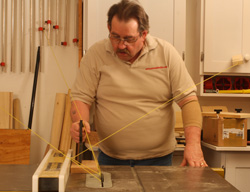 |
The yellow strings here show the general trajectories of a few kickbacks that I am aware of or (the one going by my left side) had myself. This small sample shows that trying to use operator position to increase safety is not going to work nearly as well as safety devices designed for our table saws. Click image to enlarge |
Where Do I Stand at My Table Saw?
Are you trying to dodge wood or safety equipment?
Text, photos and video by Tom Hintz
Posted - 3-30-2010
I get a reasonable number of questions regarding the best/safest place to stand while operating a table saw. I believe most folks asking this question are simply trying to be as safe as possible. However, it is obvious that some want me to make them feel better about not using the safety equipment and features that came with their table saw. The problem is that a table saw is capable of throwing wood where it wants to, not in a predictable path or pattern. It may sound logical that operator position could reduce the chances of getting hit by ejected wood to some degree but the reality is considerably more dangerous. Failing to use proper safety equipment and procedures increases your chance of having an "incident" while at the same time relegating pure operator position to a minor role overall.
Blown Pattern
If wood only flew off of a table saw in direct response to its interaction with an unprotected blade, finding a safe place to stand just might be somewhat easier than it is. The problem is that many kickback events involve the wood ricocheting off something else on the table saw. The fence is a frequent co-conspirator in kickbacks as are things like gauge blocks, miter gauges and the remaining wood on the table.
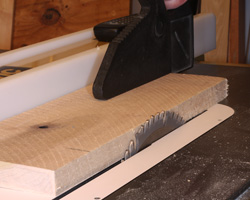 |
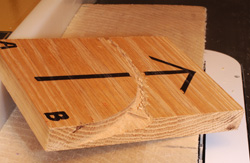 |
At the time of my major kickback I was not using the factory guards nor a riving knife. (left) I was way wrong. This is the piece of wood (right) that kicked out that day. Notice how the cut begins nearly full thickness and gets shallower as it rotated across the blade. The corner of the wood pivoted against the fence allowing the blade to shoot it at my left side even though I was standing to the left of the blade. Click images to enlarge |
|
My only hard hit at the table saw came when a kickback caught me on my left side even though I was standing well to the left of the blade. The blade grabbed the wood and used the fence as a fulcrum that redirected the piece to the left with enough force to bounce off of my left side several inches above the table surface. The piece still had enough energy to continue on, striking the wall a little over 8 feet to the left and about 3 feet behind me while gaining another five inches in altitude on the way. The piece didn't go through the drywall but it left a healthy gouge as a reminder that a 1-1/2 HP contractor saw has plenty of power to be dangerous.
Because the wood can deflect off of anything in its path the potential impact area can resemble a blown shotgun pattern. There really is no "safe" place to stand and still operate a table saw. We need to focus on being safer BEFORE the kickback by installing, maintaining and actually using our safety equipment as it was designed. Odd as it may sound that can be done and still do woodworking. I've seen it, no kidding!
Stand Natural
One of the problems with trying to develop a supposedly "safe" place to stand at the table saw is that it is seldom compatible with operating the saw effectively. That alone can increase the danger potential. If standing in this reputedly safer position makes operating the saw uncomfortable and/or forces a right-handed person to use their left hand to guide the wood, things are getting worse not better. Left-handed people are often more adept at making this kind of change because they have done so in many situations throughout their life in our decidedly right hand prejudiced world.
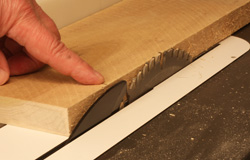 |
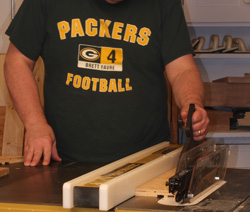 |
Using a good riving knife (left) helps keep the wood from rotating into the blade, a prime beginning of a kickback. Trying to force yourself to use your left hand (right) is not a reliable safety procedure. Even with a good blade guard in place, a right-handed person using their left hand could be forcing the wood away from the fence unintentionally. |
|
For most common cuts standing where you are most comfortable while operating the table saw positions your body to the left of the blade. That naturally reduces the chances of being struck to some degree. Some woodworkers force themselves to use their left hand when making narrow rip cuts to put the fence between them and the blade. For those who are comfortable doing that, it just might reduce the chance of being hit by a kickout but to a small degree. However if you are not comfortable (and proficient) using your left hand to guide the wood you could make matters worse trying to force yourself to do it. And, I have seen a chunk of wood zoom past the right side of my head after being ejected by the blade and glancing off or sort of tripping over the top of the fence. The fence is not designed to catch or deflect wood and does not do that all of the time.
Accept Reality
No matter how you look at this, using the safety features that came with your table saw actually makes you safer. I know the standard guard and splitter can't be used with a dado set but good push blocks can and increase your protection.
For those who have gone a long time without the factory guards, using them could take some getting used to. That might be a bit of a hassle but not nearly as much as learning how to do things minus a finger or two.
Video Tutor |
Prior to my kickback I often took my guards off thinking that if I just paid attention everything would be fine. And it was until it went wrong. Fortunately I came away with nothing more than a good-sized bruise because I was lucky that time. As soon as I returned to the table saw it had the factory guards in place and they have remained ever since. It took a little while to get used to them and that got a bunch better when I got my POWERMATIC PM2000 because its guards are very well designed and easier to use.
Take the time to adjust your factory blade guard, splitter and anti-kickback pawls to be sure they are working as they were designed to. Learning how to set up and use your safety guards efficiently could save you much more than a little time.
Related Material
Setting Up Factory Blade Guards
Have a comment on this article? - Email Me!
Back to the Tips & Tricks Directory
All written, photographic and drawn materials are property of and copyright by NewWoodworker.com LLC 2000-2019. Materials may not be used in any way without the written permission of the owner.
